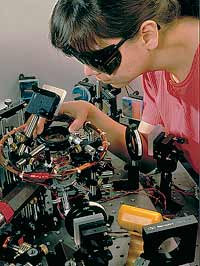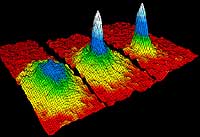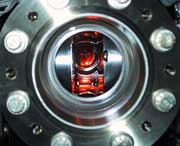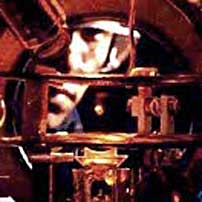Matters of State
About the Bose-Einstein Condensate—A New State of Matter

Physicist Deborah Jin of the National Institute for Standards and Technology (NIST) aligning an infrared laser in apparatus designed to create a Bose-Einstein Condensate of rubidium atoms (©Geoffrey Wheeler)
We know about solids, liquids, gases, and plasmas —these are the well-known states of matter. But now there’s another, called the Bose-Einstein condensate (BEC), and it’s been predicted for a long time. In 1924, Albert Einstein built upon work of Satyendra Bose to predict that ultracold atoms could form a new state of matter, with all the atoms overlapping.
What does it mean to say that atoms overlap? The coins in a stack of pennies don’t overlap, and neither do the gas molecules in the air we breathe. As a gas becomes colder and colder, quantum mechanics tells us that the wavelike behavior of the atoms becomes more and more important. At the lowest temperatures—within a few hundred billionths of absolute zero—the probability waves of the atoms in a gas can overlap and create, in effect, one super-atom. In this state, it hardly even makes sense to talk about individual atoms because they all behave as one collective object. This is much like the output of a laser, since all the light is the same wavelength (same color) and the waves are all in step and you can’t tell one light particle (a photon) from another. In recent developments, BECs are being used to create atom lasers, the equivalent of a laser made of light.
Research

This graphic shows how a system of ultracold atoms approaches the Bose-Einstein Condensate. As the peak becomes taller and more sharply defined, more and more atoms have “condensed” into the same state. (graphic courtesy of NIST)

Magneto-0ptic Trap at MIT (photo courtesy of the MIT BEC group)
In the 1990s, many research groups pushed small samples of gas to lower and lower temperatures with laser cooling and trapping. Then magnetic fields confine the cold gas while the most energetic atoms are allowed to evaporate away, cooling the sample further—just like the way that water evaporating on the skin cools the body. The image shows the velocities of trapped atoms as they enter the BEC state. The sharper the peak, the greater the number of atoms in the BEC.
In making the first BEC in 1995, a team led by Carl Wieman, of the University of Colorado at Boulder, and Eric Cornell, of the National Institute of Standards and Technology, trapped about 2,000 rubidium atoms in a space about 20 microns in diameter (20 x 10-6 m, or about one-tenth the thickness of a human hair). A few months later, a team led by Wolfgang Ketterle at MIT achieved a BEC with half a million sodium atoms. These three physicists shared the Nobel Prize in Physics 2001.
Links
Physics 2000
MIT

The small yellow dot in the center of the vacuum chamber is a sample of magento-optically trapped atoms at a temperature of less than 1 mK. NIST physicist Kris Helmerson observes the trap in operation. (photo courtesy of NIST)














